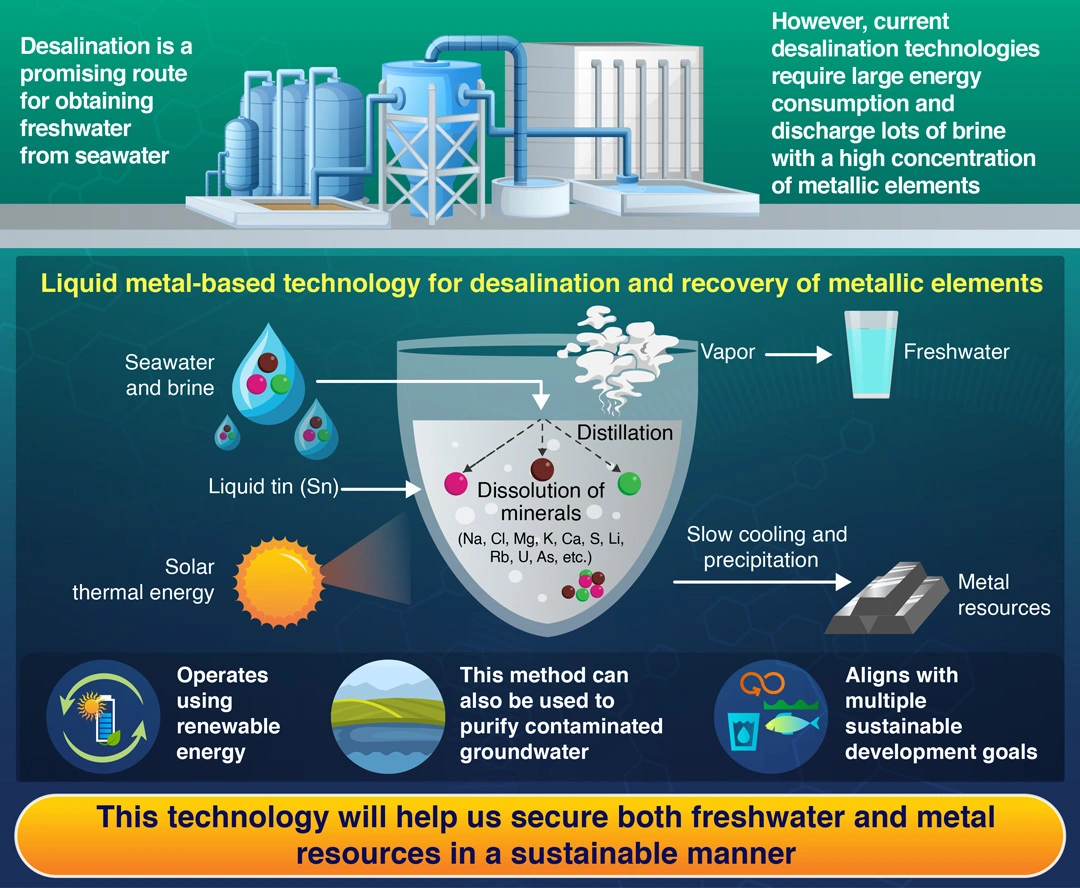Liquid metal tin is the key to sustainable desalination!
Researchers have developed a solar-powered method that uses liquid tin to purify water and recover valuable metals from seawater brine
Innovative technology using liquid metal tin can simultaneously purify water and recover valuable metals from desalination brine—as reported by researchers from Science Tokyo. Their method, which consists of spraying brine onto liquid tin heated by concentrated sunlight, distills freshwater while extracting elements like sodium, magnesium, calcium, and potassium. Through controlled cooling, these metals precipitate at different temperatures, allowing for separate recovery. Notably, this technique also effectively removes arsenic from contaminated groundwater.
Seawater Desalination Using Liquid Metal Tin

Horikawa et al. (2025) | Water Reuse | 10.2166/wrd.2025.100
Water scarcity remains one of the most pressing global challenges, affecting over two billion people worldwide. With population growth and climate change further exacerbating this problem, scientists are turning to seawater desalination as a promising solution to satisfy the ever-increasing demand for freshwater.
However, current desalination plants discharge massive amounts of brine as waste— approximately 141.5 million cubic meters daily. This solution typically contains concentrated metallic elements. Additionally, existing methods for recovering metals from brine are quite energy-intensive.
In order to address these challenges, a research team led by Associate Professor Masatoshi Kondo from Institute of Science Tokyo (Science Tokyo), Japan, has developed an innovative approach using liquid metal tin to simultaneously purify water and recover valuable metals. Their paper was made available online on February 26, 2025, and was published in Volume 15, Issue 1 of the journal Water Reuse on March 01, 2025. The study demonstrates how this technology can transform desalination brine from an environmental liability into a valuable resource. This work was co-authored by doctoral student Toranosuke Horikawa, then-bachelor student Mahiro Masuda and Assistant Professor Minho Oh, from Science Tokyo.
The proposed strategy is centered around spraying brine onto the surface of liquid tin heated to 300 °C. Upon contact, freshwater is instantly evaporated and thus distilled from the brine, while valuable elements such as sodium, magnesium, calcium, and potassium remain in the tin. “The main energy source for this type of seawater desalination can be concentrated solar power, since heat is main energy source required for this desalination process. Unlike conventional methods, large consumption of electricity is not necessary, enabling the development of a sustainable process,” explains Kondo, highlighting the technology’s use of easily accessible and renewable energy.
After minerals are dissolved into the liquid tin, a slow cooling process allows different metal elements to precipitate at specific temperatures, enabling their separate recovery. Through laboratory experiments, the researchers found that potassium begins to precipitate first, followed by sodium, calcium, and finally magnesium, enabling targeted recovery of each resource.
Another important approach that sets it apart is its versatility and efficiency. “The proposed technology for the collection and recovery of metallic elements from seawater desalination brine can also be used to distill groundwater polluted with arsenic without consuming large amounts of energy or producing waste,” notes Kondo. Groundwater contamination with arsenic is a widespread problem affecting drinking water for millions of people in regions like South Asia, particularly affecting Bangladesh, India, Vietnam, and nearby countries.
Worth noting, this innovative technology aligns with multiple sustainable development goals, providing a pathway to secure both freshwater and metal resources without generating secondary waste or significant carbon emissions. Overall, this liquid tin-based approach offers a promising solution that transforms environmental challenges into valuable opportunities, potentially revolutionizing water treatment and desalination practices worldwide.
Reference
- Authors:
- Toranosuke Horikawa1, Mahiro Masuda1, Minho Oh2, and Masatoshi Kondo3*
*Corresponding author - Title:
- Liquid metal technology for collection of metal resources from seawater desalination brine and polluted groundwater
- Journal:
- Water Reuse
- DOI:
- 10.2166/wrd.2025.100
- Affiliations:
- 1School of Engineering, Department of Mechanical Engineering, Graduate Major in Nuclear Engineering, Institute of Science Tokyo, Japan
2Department of Materials Science and Engineering, Institute of Science Tokyo, Japan
3Institute of Integrated Research, Laboratory for Zero-Carbon Energy, Institute of Science Tokyo, Japan
Related articles
Further Information
Associate Professor Masatoshi Kondo
Laboratory for Zero-Carbon Energy, Institute of Integrated Research, Institute of Science Tokyo
Contact
Public Relations Division, Institute of Science Tokyo
- Tel
- +81-3-5734-2975
- media@adm.isct.ac.jp